It’s easy to understand why plein air landscape painting first took off in Rome in the late 18th century. Visiting artists and Grand Tourists alike, keen to escape the sweltering heat, and plagues, in the city, journeyed out to beauty spots in the surrounding hills for fresher air and a spot of ‘scene painting’ – capturing famous views with more or less skill for their travel diaries and sketchbooks (no cameras or iPhones then). Such scenes were often crowded and convivial, attracting painters from every corner of Europe – and not just in summer. Would that we could flock there too, now that the dark days of winter are drawing in, and art classes are closed by Covid restrictions. Many of us have been forced by our own plague to amuse ourselves outdoors in this chilly season – so why not paint en plein air like the Impressionists, and dream of bluer skies?
In January 1906 the Nabis artist Ker-Xavier Roussel photographed Paul Cézanne painting outdoors on his most famous motif, the Mont Sainte-Victoire. Bundled up against the cold in his ancient black wool coat, grubby and torn from use, Cézanne wears not his customary straw hat but his warm felted-wool chapeau melon. He was still working en plein air in October of that year, near his studio at Les Lauves when, caught in a rainstorm, he succumbed to the chill which precipitated his final illness.
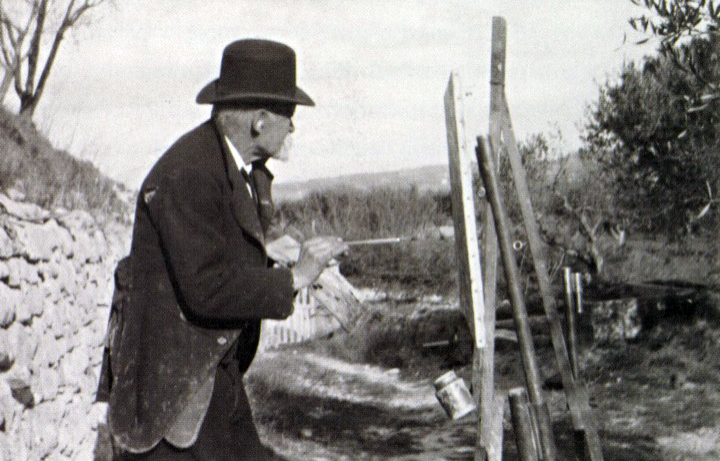
Paul Cézanne at work, photographed in 1906 by Ker-Xavier Roussel
Still, Cézanne was well aware of the climatic advantages of his beloved South. From the 1880s, Cézanne was increasingly in retreat from Paris to his home in Aix-en-Provence, where the Midi climate allowed him to paint all-year-round ‘on the motif’. Thanks to its relative warmth compared to northern France, it was especially fruitful for plein air work in winter. Cézanne’s landscapes might take weeks or even years to complete. Although the weather might be consistently clear, the light and angle of the sun changed with the seasons as did the colours before him, thus compromising the integrity of the work’s original ‘sensation’; however, Cézanne would reprise a painting at the same season the following year, to build on and gradually bring it nearer to completion.
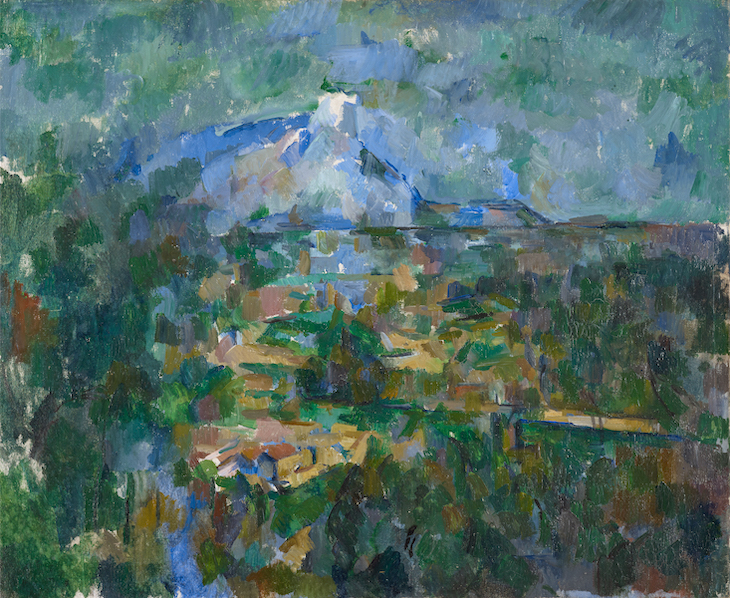
Mont Sainte-Victoire from Les Lauves (1904–06), Paul Cézanne. Kunstmuseum Basel
The approach of French artists to plein air painting had evolved during the 19th century. Small scale gradually gave way to larger, more ambitious work painted directly outdoors, often with only finishing touches added later in the studio. In his later years, Jean-Baptiste-Camille Corot himself painted larger canvases outdoors, and at 27.9 x 57.2cm his stunning oil sketch, Marsh at Arleux (1871) is by no means the largest. Here, thinly painted with rapid brushwork in a palette dominated by shades of grey, Corot captures a bout of inclement spring weather at Douai, near the French-Belgian border.
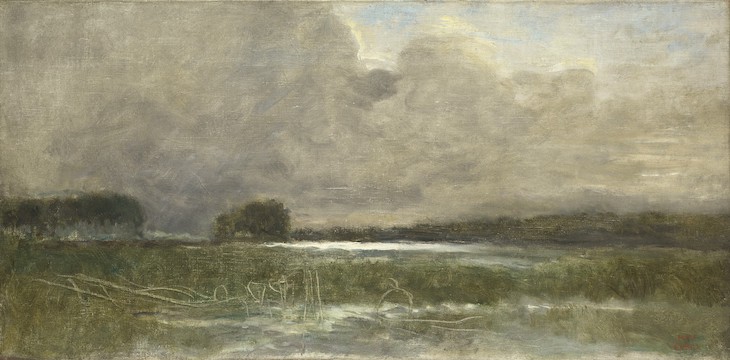
The Marsh at Arleux (1871), Jean-Baptiste-Camille Corot. Photo: © National Gallery, London
The immediacy of the work, finished quickly on the spot, is affirmed by the flamboyant calligraphy with which Corot has rendered the foreground posts and fishing gear, inscribed directly into wet paint with the wooden end of his brush: it’s the underlying pale grey canvas-primer we see exposed here. The priming tint chosen by plein air painters was vital to the speed and authenticity of the resulting work, and its colouristic unity; well chosen, it complemented the applied palette colours and could serve among these as a colour in its own right. Interestingly, a grey canvas primer was not the automatic choice as a base for winter landscapes. Swiftly executed in freezing weather conditions in early 1875, Alfred Sisley’s The Watering Place at Marly-le-Roi employs a palette of cool hues over a ginger-biscuit-coloured primer, which Sisley leaves exposed in his notably thin painting of the sky to provide a contrasting chilly glow.
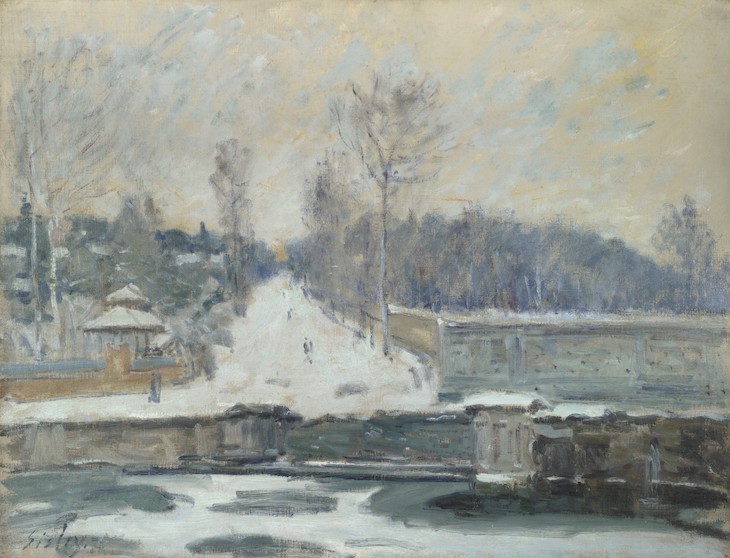
The Watering Place at Marly-le-Roi (c. 1875), Alfred Sisley. Photo: © National Gallery, London
Pierre-Auguste Renoir hated working outdoors in winter, which encroaching rheumatism in his hands made impossible; in 1907 he too moved South, to ‘Les Collettes’ near Cagnes. That inveterate plein-airiste Claude Monet was, by contrast, notorious for his wild weather exploits – whether risking loss of life and limb (plus his easel and canvases), while painting stormy seas on the Normandy beaches – or repeatedly braving frozen feet and fingers in icy conditions. He painted 17 canvases of the glorious Seine thaw of 1879–80 at Vétheuil, and a dozen views of shimmering ice flows on the Seine near Giverny in January 1893. Typically by this period he worked heavily rugged up in English tweeds and thick boots – and as I head out through the mist to my local park I imagine him in a Barbour too.
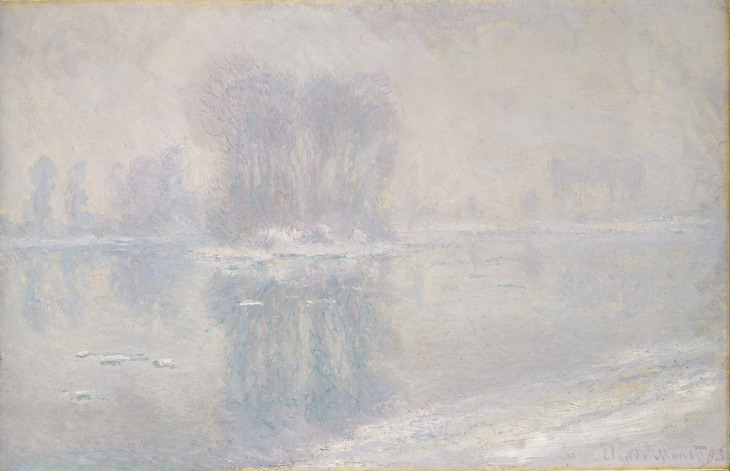
Ice Floes (1893), Claude Monet. Metropolitan Museum of Art, New York
Anthea Callen is professor emeritus at the Australian National University, Canberra and the University of Nottingham.

Cold comfort forms – the plein-air painters who braved the winter
The Watering Place at Marly-le-Roi (detail; c. 1875), Alfred Sisley. Photo: © National Gallery, London
Share
It’s easy to understand why plein air landscape painting first took off in Rome in the late 18th century. Visiting artists and Grand Tourists alike, keen to escape the sweltering heat, and plagues, in the city, journeyed out to beauty spots in the surrounding hills for fresher air and a spot of ‘scene painting’ – capturing famous views with more or less skill for their travel diaries and sketchbooks (no cameras or iPhones then). Such scenes were often crowded and convivial, attracting painters from every corner of Europe – and not just in summer. Would that we could flock there too, now that the dark days of winter are drawing in, and art classes are closed by Covid restrictions. Many of us have been forced by our own plague to amuse ourselves outdoors in this chilly season – so why not paint en plein air like the Impressionists, and dream of bluer skies?
In January 1906 the Nabis artist Ker-Xavier Roussel photographed Paul Cézanne painting outdoors on his most famous motif, the Mont Sainte-Victoire. Bundled up against the cold in his ancient black wool coat, grubby and torn from use, Cézanne wears not his customary straw hat but his warm felted-wool chapeau melon. He was still working en plein air in October of that year, near his studio at Les Lauves when, caught in a rainstorm, he succumbed to the chill which precipitated his final illness.
Paul Cézanne at work, photographed in 1906 by Ker-Xavier Roussel
Still, Cézanne was well aware of the climatic advantages of his beloved South. From the 1880s, Cézanne was increasingly in retreat from Paris to his home in Aix-en-Provence, where the Midi climate allowed him to paint all-year-round ‘on the motif’. Thanks to its relative warmth compared to northern France, it was especially fruitful for plein air work in winter. Cézanne’s landscapes might take weeks or even years to complete. Although the weather might be consistently clear, the light and angle of the sun changed with the seasons as did the colours before him, thus compromising the integrity of the work’s original ‘sensation’; however, Cézanne would reprise a painting at the same season the following year, to build on and gradually bring it nearer to completion.
Mont Sainte-Victoire from Les Lauves (1904–06), Paul Cézanne. Kunstmuseum Basel
The approach of French artists to plein air painting had evolved during the 19th century. Small scale gradually gave way to larger, more ambitious work painted directly outdoors, often with only finishing touches added later in the studio. In his later years, Jean-Baptiste-Camille Corot himself painted larger canvases outdoors, and at 27.9 x 57.2cm his stunning oil sketch, Marsh at Arleux (1871) is by no means the largest. Here, thinly painted with rapid brushwork in a palette dominated by shades of grey, Corot captures a bout of inclement spring weather at Douai, near the French-Belgian border.
The Marsh at Arleux (1871), Jean-Baptiste-Camille Corot. Photo: © National Gallery, London
The immediacy of the work, finished quickly on the spot, is affirmed by the flamboyant calligraphy with which Corot has rendered the foreground posts and fishing gear, inscribed directly into wet paint with the wooden end of his brush: it’s the underlying pale grey canvas-primer we see exposed here. The priming tint chosen by plein air painters was vital to the speed and authenticity of the resulting work, and its colouristic unity; well chosen, it complemented the applied palette colours and could serve among these as a colour in its own right. Interestingly, a grey canvas primer was not the automatic choice as a base for winter landscapes. Swiftly executed in freezing weather conditions in early 1875, Alfred Sisley’s The Watering Place at Marly-le-Roi employs a palette of cool hues over a ginger-biscuit-coloured primer, which Sisley leaves exposed in his notably thin painting of the sky to provide a contrasting chilly glow.
The Watering Place at Marly-le-Roi (c. 1875), Alfred Sisley. Photo: © National Gallery, London
Pierre-Auguste Renoir hated working outdoors in winter, which encroaching rheumatism in his hands made impossible; in 1907 he too moved South, to ‘Les Collettes’ near Cagnes. That inveterate plein-airiste Claude Monet was, by contrast, notorious for his wild weather exploits – whether risking loss of life and limb (plus his easel and canvases), while painting stormy seas on the Normandy beaches – or repeatedly braving frozen feet and fingers in icy conditions. He painted 17 canvases of the glorious Seine thaw of 1879–80 at Vétheuil, and a dozen views of shimmering ice flows on the Seine near Giverny in January 1893. Typically by this period he worked heavily rugged up in English tweeds and thick boots – and as I head out through the mist to my local park I imagine him in a Barbour too.
Ice Floes (1893), Claude Monet. Metropolitan Museum of Art, New York
Anthea Callen is professor emeritus at the Australian National University, Canberra and the University of Nottingham.
Unlimited access from just $16 every 3 months
Subscribe to get unlimited and exclusive access to the top art stories, interviews and exhibition reviews.
Share
Recommended for you
How Monet’s water lilies took root across the pond
The French painter’s late style influenced a generation of American Abstract Expressionists
‘This is a book about a man who painted, not about the paintings he made’
A new biography of Renoir emphasises the role the painter’s domestic life played in his work
How Daubigny inspired Impressionism
A modest exhibition at the Scottish National Gallery makes clear the big impact Daubigny had on modern art